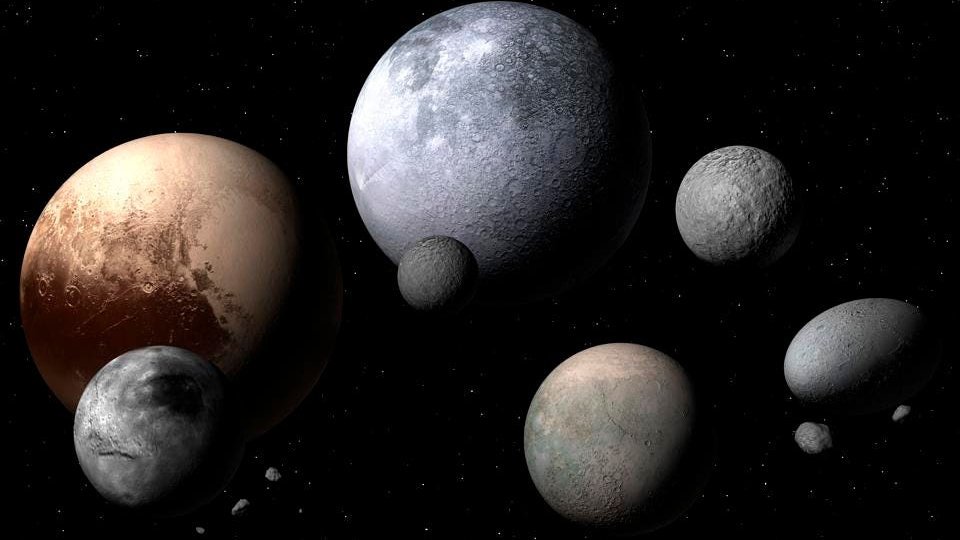Beyond the familiar giants like Jupiter and Saturn, our solar system harbors a diverse population of celestial bodies, including dwarf planets. These smaller, enigmatic worlds hold valuable insights into the formation and evolution of our cosmic neighborhood. Join us as we embark on a journey to unveil the mysteries of dwarf planets, exploring their characteristics, discovery, and significance in the vast tapestry of our solar system.
Defining Dwarf Planets
1. Characteristics of Dwarf Planets
Dwarf planets share some similarities with traditional planets but possess distinct features. They orbit the Sun, are spherical in shape, lack the gravitational dominance to clear their orbits entirely, and are not classified as moons.
2. Criteria for Classification
The International Astronomical Union (IAU) sets specific criteria for classifying celestial bodies as dwarf planets. These criteria include orbiting the Sun, sufficient mass for a nearly spherical shape, and not having cleared their orbital path of other debris.
Known Dwarf Planets in Our Solar System
1. Pluto: A Former Planet
Pluto, once considered the ninth planet, was reclassified as a dwarf planet in 2006. It resides in the Kuiper Belt, a region beyond Neptune populated by icy bodies.
2. Eris: Pluto’s Twin
Eris, a distant dwarf planet slightly smaller than Pluto, played a role in the reevaluation of Pluto’s status. It resides in the scattered disc, a region with objects that have highly elliptical orbits.
The Kuiper Belt and Beyond
1. Kuiper Belt: Home to Dwarf Planets
The Kuiper Belt, a region of the solar system beyond Neptune, hosts numerous dwarf planets. These icy bodies provide valuable information about the early solar system’s conditions.
2. Haumea and Makemake
Haumea, a peculiar elongated dwarf planet, and Makemake, a distant and icy world, are among the notable members of the Kuiper Belt.

New Horizons Mission: Pluto Close-Up
1. Historic Flyby of Pluto
NASA’s New Horizons spacecraft conducted a historic flyby of Pluto in 2015, capturing detailed images and data that revolutionized our understanding of this distant dwarf planet.
2. Discoveries and Mysteries
New Horizons revealed diverse landscapes on Pluto, including icy mountains and a heart-shaped region named Tombaugh Regio. The mission raised new questions about the dynamic nature of dwarf planets.
Ceres: A Dwarf Planet in the Asteroid Belt
1. Ceres: An Asteroid Belt Resident
Ceres, the largest object in the asteroid belt between Mars and Jupiter, holds the distinction of being the only dwarf planet in the inner solar system.
2. Dawn Mission to Ceres
NASA’s Dawn spacecraft orbited Ceres from 2015 to 2018, uncovering mysteries such as bright spots in Occator Crater and suggesting the presence of a subsurface ocean.
Beyond Pluto: Potential Dwarf Planets
1. Trans-Neptunian Objects (TNOs)
The outer reaches of the solar system are populated by Trans-Neptunian Objects (TNOs), including potential dwarf planets awaiting discovery and characterization.
2. Ongoing Surveys and Discoveries
Advancements in observational technology, such as large telescopes and space-based surveys, continue to reveal new dwarf planets in the distant realms of our solar system.
Scientific Significance
1. Window into Solar System Formation
Dwarf planets offer a window into the early conditions of the solar system, preserving clues about the processes that shaped the planets, moons, and smaller bodies.
2. Understanding Planetary Diversity
Studying the diverse compositions and characteristics of dwarf planets enhances our understanding of planetary diversity and the factors influencing their evolution.
The Quest for More Knowledge
1. Future Missions and Exploration
As technology advances, future missions may target dwarf planets for close-up exploration, providing a deeper understanding of these intriguing worlds.
2. Citizen Science and Amateur Astronomy
Citizen scientists and amateur astronomers play a crucial role in the discovery and monitoring of dwarf planets, contributing valuable data to the scientific community.
Conclusion
Dwarf planets, though smaller in size, carry substantial significance in unraveling the mysteries of our solar system’s formation and evolution. From the historic reclassification of Pluto to the ongoing discoveries in the Kuiper Belt and beyond, these celestial bodies continue to captivate scientists and stargazers alike. As technology and exploration efforts progress, dwarf planets will remain focal points for scientific inquiry, offering insights into the dynamic processes that have shaped our cosmic neighborhood over billions of years. The journey to unveil the secrets of dwarf planets is an ongoing odyssey that invites us to explore the farthest reaches of our celestial home.

